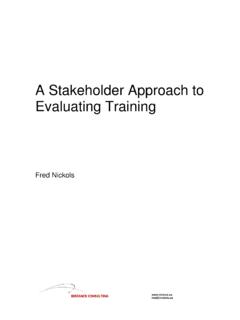Transcription of Communities of Practice Overview
1 Communities of Practice An Overview Fred Nickols Fred Nickols 2003 All rights reserved CoP: An Overview Fred Nickols 2003 2 Introduction This Overview lays out some basic information about Communities of Practice (CoPs) that is re-levant to two audiences: For those with a general interest in CoPs, this document provides a good Overview . Addi-tional information about CoPs is easily obtained via the recommended readings found at the end of this Overview . For those who think they might be interested in sponsoring or starting up a CoP, this over-view serves as a starting point. More detailed guidance is provided in the accompanying Start Up Kit.
2 Communities of Practice Defined Communities of Practice (CoPs) are groups that form to share what they know and to learn from one another regarding some aspects of their work. Although the term Community of Practice is new, CoPs are not. Such groups have been around ever since people in organizations realized they could benefit from sharing their knowledge, in-sights, and experiences with others who have similar interests or goals. One of the best-known, early examples of a CoP is one formed by the copy machine repair tech-nicians at Xerox Corporation. Through networking and sharing their experiences, particularly the problems they encountered and the solutions they devised, a core group of these technicians proved extremely effective in improving the efficiency and effectiveness of efforts to diagnose and repair Xerox customers copy machines.
3 The impact on customer satisfaction and the busi-ness value to Xerox was invaluable. Yet, for the most part, this was a voluntary, informal gather-ing and sharing of expertise, not a corporate program (however, once the company realized the value of the knowledge being created by this CoP, steps were taken to support and enhance the efforts of the group). The Business Case for CoPs Ultimately, all companies seek sustainable competitive advantage -- in processes as well as in products and services. Many people see this as tied to a process of continuing innovation. In turn, innovation depends on human qualities such as curiosity, insight, ideas and determination.
4 In the last analysis, innovation depends on people applying knowledge in ways that yield new solutions to old and new problems. Much of what people do in organizations occurs in the context of Communities of Practice . There is where best practices and innovations first emerge and where the solutions to shared problems are first identified. For this reason, many companies are determined to encourage, promote, and support CoPs, especially in areas, processes and functions where an edge in performance provides a competitive advantage (whether it be financial, operational or in the eyes of the customer). It takes time for CoPs to emerge, to flourish and to become productive.
5 More important, they can't be mandated or managed in a heavy-handed way. CoPs, then, are an investment in the or-ganization's future, not a quick fix to be applied for the sake of short-term gain. Most important, many will exist whether or not management chooses to encourage and support them; they are a natural part of organizational life. And that means they require a minimal investment on the part of the organization. CoP: An Overview Fred Nickols 2003 3 The business case for CoPs is this: for a quite modest investment in terms of today's resources, organizations can reap huge rewards in terms of tomorrow's results. Types of CoPs There are two types of Communities of Practice : 1.
6 Self-Organizing 2. Sponsored Self-Organizing CoPs are self-governing as well. They pursue the shared interests of the group s members. These CoPs add value to a company by sharing lessons learned, acting as distribution points for best and emerging practices , providing forums in which issues and problems can be raised and resolved and, in general, by learning from each other. Owing to their voluntary, in-formal nature, self-organizing CoPs are fragile yet extremely resilient. They are fragile in that attempts to manage or control them can result in the group members disbanding or going under-ground instead of sharing their expertise and knowledge more broadly.
7 They are extremely resi-lient in that members come and go as interests and issues shift and evolve. Over time, then, they adapt. They can even evolve into a formal or sponsored CoP. Or, they might disband if enough of the members decide they are no longer deriving any benefit from their membership. Sponsored CoPs are initiated, chartered, and supported by management. Sponsored CoPs are expected to produce measurable results that benefit the company. They get needed resources and they have more formal roles and responsibilities. Even so, they are much more self-governing and wide-ranging than the typical cross-functional project team. A CoP (Sponsored or Self-Organizing) might be established to focus on almost any area of inter-est to the employees or the management of a company.
8 Some of the more common focal points around which CoPs organize are: A profession such as engineering, law, medicine or research. A work-related function or process such as supplier management, production, distribution, purchasing, customer service or sales. A recurring, nagging problem situated in a process or function. A topic such as technology, intellectual capital, knowledge management or innovation. An industry such as automotive, banking and other financial services, healthcare or travel. Basic CoP Charter The basic charter for all Sponsored Communities of Practice (CoPs) has three major objectives: 1. To enable colleagues to learn from one another through the sharing of issues, ideas, lessons learned, problems and their solutions, research findings and other relevant aspects of their mutual interest; 2.
9 To more broadly share and better leverage the learning that occurs in the CoP with others; CoP: An Overview Fred Nickols 2003 4 3. To generate tangible, measurable, value-added benefits to the business. Mission & Outcomes The mission and outcomes of a particular CoP depend upon the issue, process, or Practice area around which it is organized and upon which it is focused. In general, however, the Mis-sion/Outcomes encompass: stimulating interaction fostering learning creating new knowledge and identifying and sharing best practices Roles & Responsibilities The key roles and responsibilities associated with a Sponsored CoP are: Champion The Champion provides enthusiasm and energy for organizing meetings and communications.
10 The Champion is the chief orga-nizer of events, and the administrator of communications. Members Members interact with each other, sharing information, insights and experiences, participating in discussions and raising issues and concerns regarding common needs and requirements. Their primary responsibility is to participate actively, to learn and to share their learning. Facilitator The Facilitator is responsible for clarifying communications, drawing out the reticent, ensuring that dissenting points of view are heard and understood, posing questions to further discussion and keeping discussions on topic all subject to the will of the group.












